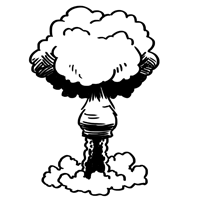Soldiers suffered as a result
On Sept. 14, 1954, 45,000
soldiers from the Soviet Army’s 270th Rifle Division and other units
took shelter in trenches and bunkers as they waited for the order to
advance.
The 270th Rifles
had fought at Stalingrad in 1942 and at Kursk in ’43. On this day, just
north of the Russian-Kazakhstan border, it was about to become the first
Soviet formation to train for nuclear war.
Administrators
had selected this hilly, forested region of the Orenberg Steppes for
the Totskoye atomic test, owing to the area’s topographic similarity to
Western Europe, where Moscow planned to wage atomic combat.
Soldiers
had been arriving for three months. There was a lot of work to do.
Three miles from the planned nuclear epicenter, they built bunkers and
pillboxes. Seven miles out, there were the trenches. Planners scattered
old tanks and other vehicles across the landscape so they could judge
the effects of the atomic blast.
Planners
tethered cows, horses and other animals at various distances from the
blast site. Along with the soldiers, they were test subjects in the
Soviets’ efforts to understand how flesh and blood might respond to
nuclear explosions.
And then
there were the civilians. “At the time [of the exercise], about a
million people lived within 100 miles of the test site,” The New York Times reported in 1993.
These civilians were going to be in for a shock when the 20-kiloton nuclear warhead went off, as the government had failed to notify many of them that this was anything other than a conventional military training exercise.
The Red Bomb,
a Discovery Channel documentary from 1994, featured Ivan Skvortsov and
Vasily Kovalyov, two Red Army veterans who took part in the Totskoye
exercise.
Kovalyov was one
of the soldiers sheltering in the protective fieldworks. He described
the initial experience as “a flash that blinded the men in the trench.”
“Then
the explosion took place,” Kovalyov added. “It was unusual. Now, I had
fought in the war and I had seen explosions of conventional ammunition
during the Second World War. But that explosion was very sharp, very
abrupt. And when the explosion went off there was a blinding lightning
so to speak. A powerful beam, very powerful beam.”
“We
had black pieces of glass installed in our gas masks,” Kovalyov said.
“You could hardly even see the sun through those glasses. But that light
was stronger than an electric arc welder.”
Skvortsov reported a similar
experience. “Of course, we covered our eyes with our hands as we had
been told to do, but we crouched in the bottom of the trench, and this
was followed by a sensation like an earthquake,” he said. “It was as if
we were on board a large seagoing ship.”
After
the nuclear device exploded, officers ordered Skvortsov and his fellow
soldiers to stage a giant mock battle. Marshall of the Soviet Union
Georgy Zhukov and others watched from a distant command bunker.
The Soviet soldiers had not received much protective gear beyond gas masks.
“We
received the order to break cover, board the trucks and move forward to
the firing position, the site of stage two of the exercise, followed up
by an attack on the enemy defensive position,” Skvortsov recalled. “The
moment we got out of the trenches, we saw a gigantic mushroom cloud
rising in the distance.”
One
point of the Totskoye nuclear exercise was to help Soviet officials
assess the psychological effect of a nearby nuclear explosion on the
country’s own soldiers.
The
Soviets weren’t alone in conducting troop exercises with live atomic
weapons.
Three years earlier in 1951, the United States conducted a
similar—though slightly safer and less secretive—series of tests under
the code name “Desert Rock.”
The
first of these trials involved 6,500 troops sheltering from, and then
conducting maneuvers around, a 31-kiloton nuclear blast. No Americans
are reported to have died during the exercises, although everyone present was exposed to radiation.
Eventually,
above-average rates of thyroid cancer and leukemia manifested among the
test subjects. In 1990, the U.S. Congress pass the Radiation Exposure
Compensation Act, entitling survivors of the exercise to $75,000 in
compensation.
The Russian
experience was more tragic. “In the 1960s, there was a definite
explosion in tumorous illnesses” in the Orenberg Steppes, Dr. Nikolay
Sidorov said in The Red Bomb.
“At
the end of 1991, we had 28,000 people suffering from tumorous illnesses
in the province, and this trend is growing stronger every year,”
Sidorov continued. “If we compare the statistics relating to 1950 with
those for the current years [1994], we will see that the number of cases
has gone up 500 percent, and the mortality rate accordingly as a
consequence.”
Russia has no laws similar to the Radiation Exposure Compensation Act.
by ELLIOT CARTER. medium.com
Patriot AESA Long Range Air Defence Missile System Global Solutions
Space Missile Defense Conference 2012 Future Military Assets Concepts


Post a Comment Blogger Facebook Disqus